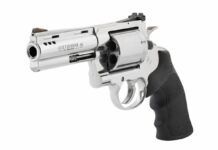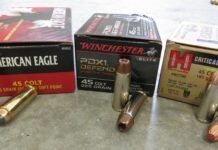When new revolvers are introduced, they don’t get the fanfare afforded the latest semi-auto. That’s why you might have missed out on the latest crop of big-bore wheelguns.
In this test we will try to make up for it by pitting two steel-framed forty-fours against an ultra-lightweight revolver of the same caliber — Taurus’s 444MULTI, $666 — that could make carrying a bigger gun more inviting. The stainless-steel guns are the $916 Smith & Wesson Model 629 No. 163603 and Ruger’s $780 Redhawk KRH-444.
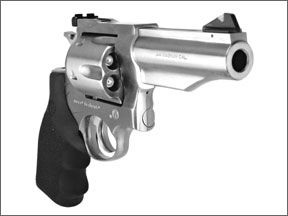
If there is any comparison to be drawn between these revolvers and the world of semi-automatic pistols, it is perhaps the appeal of the big bullet. The small-bore high-capacity frenzy seems to have abated, and now it seems that every manufacturer is making a 45-caliber pistol. With the release of more .44s, revolver makers may also be saying when capacity is limited, why not chamber a larger caliber? But when that thinking includes .44 Magnum/.44 Special ammo, two important questions remain: Will the Magnum ammunition prove too punishing?, and will the .44 Specials be accurate enough?
To answer these questions we tested from a distance of 25 yards with two loads of .44 Remington Magnum and two loads of .44 S&W Special. They were 240-grain Federal Fusion .44 Magnum No. F44FS1, 240-grain American Eagle .44 Magnum jacketed hollow points No. AE44A, 200-grain Winchester .44 Special Silvertip HP No. X44STHPS2, and Winchester’s 246-grain lead roundnose ammunition No. X44SP.
Before testing each gun, we lubricated it with BreakFree CLP. Lubrication points on the revolvers were the barrel and chamber bores, the ratchet lugs, and the bushing in front of the cylinder. We also pulled back the hammer and placed a few drops of oil inside the frame. Whenever we transitioned from the Special to the Magnum loads, we scrubbed inside each chamber. This is because the shorter Special rounds can deposit debris at the hotspot where the tip of each case empties into the chambers. A buildup of debris can reduce the volume of the chamber and increase pressure. In extreme conditions, such as when it becomes necessary to push the longer magnum rounds into place, the extra pressure can be dangerous.
To collect accuracy data, all shots from the bench were fired single action only from a distance of 25 yards. Repeat fire was tested using the double-action trigger at shorter distances. We didn’t expect to be able to shoot the magnum ammunition quickly, but we wondered about the .44 Special loads. Was there enough stopping power from each round to justify a shorter recovery time between each shot? Let’s see how our six shooters measured up.
Smith & Wesson Model 629 No. 163603, $916
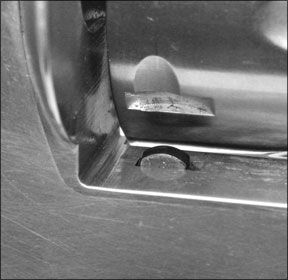
Our 629 was a stainless-steel revolver of classic Smith & Wesson design. The profile of the barrel showed a rounded shroud with a flat top. Underneath was a shrouded ejector rod with the underlug stopping about 1 inch from the muzzle. Above was a ramped front sight with the viewing edge scored to reduce glare, save for the orange plastic insert.
The top of the barrel was satin finished, and the center section was grooved to reduce glare. The sides of the barrel were polished. From the recessed muzzle, the edges of the lands inside the bore were visible and appeared to be sharp. The adjustable rear sight unit was black, lined to further reduce glare and sat on a satin frame finish. This unit was removable. Underneath were holes drilled and tapped to accept a scope mount.
The model 629 featured a hammer with a wide tang. The cylinder latch was contoured on its lower side to clear a speedloader. This evolved from competition shooters, many of whom simply machined off the lower portion of the latch. Just above the latch was a key-operated lock that was capable of stalling the action. The sides of the frame were beautifully polished. The frame style was a round butt design, meaning the area of the frame that housed the leaf style mainspring was curved inward at its bottom. But the Hogue MonoGrip added length in a manner that replicated a square-butt design. It also exposed the rear of the grip frame. Whereas the round butt was meant to aid concealment, the square butt provides more grip area. The MonoGrip design attaches from the bottom and does away with the possibility of individual panels coming loose. For more details, log on to getgrip.com.
The cylinder was fluted, and the ejector star was not held in place by the more traditional pegs to brace and align its position. Instead, the extremities of the star formed a square shape rather than a circle. The job of the star is to mesh with the outer rings of the chambers so that it fits underneath the rims of the cartridges. This enables the star to pry out the empty cases. In the world of the semi-autos, production guns often feature a beveled magazine well as standard equipment. The comparable modification to a revolver is the chamfering of each chamber mouth. This breaks the ninety-degree edge of the chambers and makes reloading much faster. But no manufacturer that we know of has seen fit to offer this as a standard feature.
At the range we noticed two shortcomings, one of which would disqualify our Smith & Wesson from an A-rating or a Buy It nod. The less serious malady was that the ejector rod would back out, making the cylinder difficult to open. This is not unusual, and the remedy for this nuisance is the careful application of LocTite. The more serious problem was that the cylinder often unlocked after ignition, even after firing the milder .44 Special rounds. This left the chamber out of alignment and the hand that drives against the ratchet was out of position. The shooter needed to turn the cylinder manually until the lock slipped into the groove on the outside of the cylinder. Then the gun could be made ready to fire. We experienced this in both single- and double-action mode.
In terms of accuracy we managed to print some very impressive groups despite glare from the front sight. The source of the glare was the orange insert. If only it had been lined like the metallic portion of the blade. The most accurate rounds were the Federal Fusion ammunition that featured a closed tip designed to expand on impact. The American Eagle ammunition was less controllable in our 629, yielding a range in group size from 2.0 inches to 3.2 inches across. Groups fired with the .44 Special rounds averaged about 2.0 inches in size.
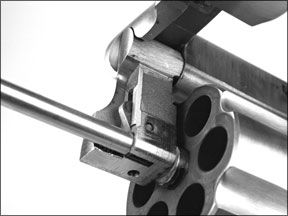
Ruger Redhawk KRH-444, $780
Like the Smith & Wesson 629, Ruger’s stout-looking 4-inch Redhawk cut a profile of classic lines unique to its manufacturer.
Only available in stainless steel, the KRH-444 employed a brushed finish. The boxy frame featured a push-button cylinder latch, broad top strap, and a fully adjustable rear sight fixed by a short stem pinned into place.
The ramped front sight was a separate unit also pinned into place. It was black with a plastic orange-colored insert. The front of the unit was beveled for easier holstering, and except for the insert, the edges were lined to reduce glare. We didn’t experience quite as much glare from the insert as we did with the Smith & Wesson, most likely because the ramp was cut at a steeper angle.
The barrel carried just enough underlug to shroud the ejector rod, and the grooved flat top of the barrel was most pronounced. The cylinder offered two lockup points by way of pressure at the rear of the ejector rod and a detent latch located on the crane that interlocked with the frame just below the shroud for the ejector rod. The tip of the ejector rod does not play a part in lockup, and it was not screwed into place. It couldn’t back out and make cylinder release difficult. The timing lugs were cut deeply into the fluted cylinder, and the cylinder stop was taller and more heavily sprung than on the Smith & Wesson. There was no provision for an internal lock.
Ruger has recently begun offering Hogue grips with its Redhawks. Our revolver came with Hogue’s Bantam grip in place. This is the first time we have seen this grip on a large revolver, and it worked very well. The Bantam helps shorten the gun by leaving the back of the grip frame completely exposed. Shock absorption was addressed by evenly filling the hand with a bulbous profile. Given the Ruger was the heaviest gun in our test by about 7 ounces, we still would credit the Bantam grip with making the Ruger the most comfortable of our test guns to shoot. The Bantam was a slip-on grip that required a supplied tool to pry it from the frame. Underneath the grip we saw the mainspring action was supplied by a combination of a lever and a coil spring. This was more complicated than the single-leaf-spring Smith Wesson or the single-coil-spring Taurus designs. Nevertheless, the double-action trigger was predictable and smooth. The shooter had plenty of feedback by way of telltale clicking and cylinder rotation. The Redhawk was the easiest gun to shoot accurately in our double-action repeat-fire tests.
From the bench the Federal Fusion ammunition in combination with the Redhawk produced the best overall performance. Velocity was about 70 fps less than the 629, but our best five-shot group measured 1 inch across. Groups produced firing the American Eagle ammunition were about the same as the Smith & Wesson, with a deficit in average velocity of about 40 fps. Accuracy firing our choices of .44 Special ammunition was less satisfactory, with groups measuring 3 inches across and more.
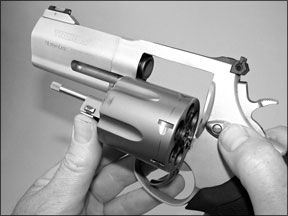
Taurus 444MULTI .44 Magnum, $666
Taurus International’s entry into the ultralight big-gun field is a 28-ounce six-shooter constructed of titanium and aluminum. It is actually a lightweight rendering of the Raging Bull that Taurus refers to as “the perfect packing gun for the hunter.” But we are going to look at this gun as a possible self-defense weapon in the civilized world.
Taurus told us that the frame was aluminum and the cylinder was titanium. The barrel was steel, and we could see a steel insert above the forcing cone to shield the frame from being cut by the gases that escape at this point during ignition. The ejector rod did not take part in lockup, but a second cylinder latch was mounted on the crane. Both the forward latch and the more traditional latch mounted to the rear (contoured for speed loading) had to be operated simultaneously to swing the cylinder away from the frame.
On the Taurus website, the gun appears in in its Shadow Gray shade, but ours was matte stainless. It had an adjustable rear sight and a red light gathering sight up front. The filament was captured in a blade that presented a square profile to the shooter so that one could align the shot with either the red dot or the traditional light bars that appear on either side when seen through the rear notch.
The barrel shroud was shaped with a deep underlug that naturally enclosed the ejector rod. The crown of the barrel was recessed, so we measured actual barrel length from the forcing cone to crown to be about 3.8 inches. The cylinder was fluted, and the ejector star utilized pegs for location. A key-operated lock mounted in the hammer just below the tang could be used to freeze the action. Turn the key and the lock popped up to prevent the hammer from being raised.
The Raging Bull grip featured an insert of softer material that covered the back strap. Fastened to the bottom of the grip frame with an Allen screw, we felt this two-piece design provided an excellent grip. With the grip removed, we saw a simple strut and coil mainspring to drive the hammer.
At the range we found the single-action trigger was neutral in feel without a hint of creep. But as one might expect with an ultra-lightweight .44 Magnum, control was the biggest detriment to accuracy. Groups fired with the 240-grain Fusion ammunition averaged 3.4 inches. The American Eagle rounds produced an average group measuring 3.8 inches across. The .44 Special 246-grain LRN (lead roundnose) slugs grouped in an average we calculated as 3.1 inches. But in the 200-grain Winchester Silvertip HP rounds, the Taurus found its groove. We were able to print five shot groups ranging from 1.8 inches to 2.3 inches across.
Looking at the gaping holes produced by the .44 Special rounds, we were satisfied with the defensive capability of the super lightweight Taurus. Firing double action however, the way that this gun would most likely be used in a confrontation, was not as consistent as we would have liked. The trigger felt uneven as though the resistance we encountered varied from shot to shot. Sometimes the movement of the rounds or empty cases can interfere with rotation or add resistance. But even with the gun unloaded, we noticed that our double action press was different from shot to shot.
Checking trigger pull weight with a Chatillon scale, we found that resistance varied as much as 4 pounds between the lightest double action pull and the heaviest, which required 16 pounds to turn the cylinder and raise the hammer until it dropped. We think this could be improved by carefully matching the ratchets to the lever (hand), which turned the cylinder.
Given the Taurus 444MULTI was, in our opinion, better suited for .44 Special ammunition, we decided to fire some MagSafe frangible ammunition to see what kind of power we could produce (magsafeonline.com). We chose MagSafe’s 94-grain SWAT load, which flew at an average velocity of 1816 fps from the Taurus barrel. Muzzle energy was computed to an average of 689 foot-pounds. This was less powerful than the magnum loads, but more than 2.5 times as powerful as the .44 Special rounds. Report was louder, but recoil was comparable to our other .44 Special JHP loads. Continuing our tests at Phil Oxley’s Impact Zone (theimpactzone.us), we found that these rounds would savage through 4 inches of .25PCF preserved wood before disintegrating.
0907_REVOLVERS_ACCURACY_DATA.pdf
SMITH_WESSON_REVOLVER_0907.pdf
RUGER_REDHAWK_REVOLVER_0907.pdf


























